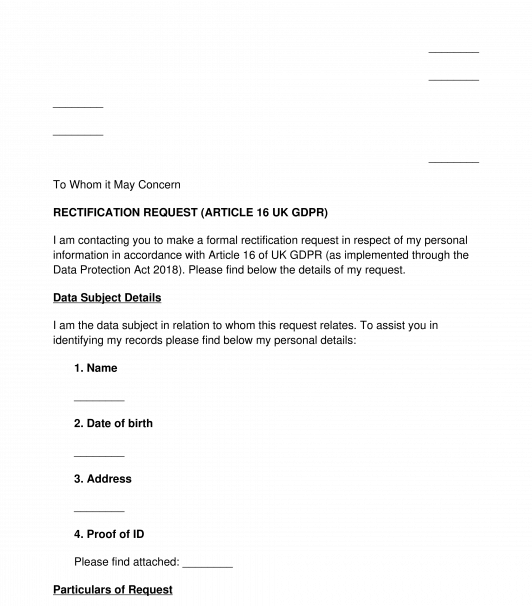 13/09/2025
13/09/2025

Answer a few questions and your document is created automatically.

Your document is ready! You will receive it in Word and PDF formats. You will be able to modify it.

 13/09/2025
13/09/2025
 Word and PDF
Word and PDF
 2 pages
2 pages
This document takes the form of a letter and can be used by an individual in order to make a formal request to a business, organisation or body for the correction of their personal records. This type of request is formally known as a 'rectification request'. The document can be used by an individual in the United Kingdom.
If a business, organisation or body holds information in respect of an individual, that individual will be referred to as a 'data subject'. A data subject has a number of rights in respect of the processing of that data. Included within those rights is the right to rectification.
Right to Rectification
Article 16 of the UK GDPR confirms that a data subject shall have the right to obtain the rectification of inaccurate personal data concerning them.
Accuracy Principle
Article 5(1)(d) of the UK GDPR also confirms, in relation to personal data that:
- it must be accurate; and
- where necessary, it must be kept up to date; and
- every reasonable step must be taken to ensure that personal data which is inaccurate is erased or rectified without delay.
An individual may wish to make a rectification request for a number of reasons. For example:
Factually inaccurate
The Data Protection Act 2018 defines inaccurate, in relation to personal data, as incorrect or misleading as to any matter of fact.
There are other types of rights that an individual may also wish to exercise in respect of their personal data. We have documents available to assist with:
This document should be completed by confirming all the relevant information. The factually incorrect information will be outlined first, before setting out the relevant corrections. It can be helpful to provide evidence to support the basis of the request. In other words, this will be relevant evidence which supports the data subject's case that the information which is held by the recipient is factually inaccurate.
Once the document has been completed, it can be sent as a formal request either by letter in the post or electronically by attaching it to an email.
The request should be processed without delay and by no later than one calendar month starting from the date upon which the request was received. In certain circumstances, this time frame can be extended by a further two months if the request is particularly complex. In this circumstance, the data subject should be notified of this extension within the initial one month period.
If the request is 'manifestly unfounded or excessive', the recipient may ask for a fee in order to process the request.
The retained General Data Protection Regulation 2016/679 (UK GDPR).
The Data Protection Act 2018.
You fill out a form. The document is created before your eyes as you respond to the questions.
At the end, you receive it in Word and PDF formats. You can modify it and reuse it.
A guide to help you: How to Send a Letter
Country: United Kingdom